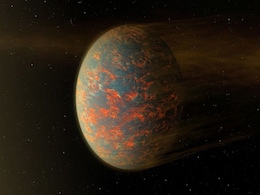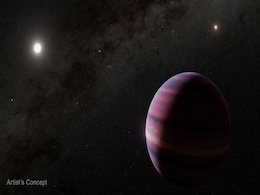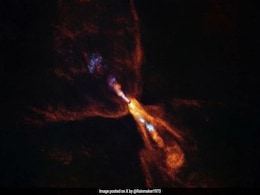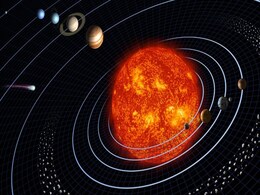New Planet Formation
- All
- News
-

New Study Challenges Long-Held Beliefs About Formation Of The Moon
- Monday November 24, 2025
- Science | Edited by Astitva Raj
According to researchers, the composition of a planet or celestial body holds the entire story of its formation and origin.
-
 www.ndtv.com
www.ndtv.com
-

NASA’s ESCAPADE Mission Will Send Twin Probes to Uncover Mars’s Atmospheric Secrets
- Monday November 10, 2025
- Written by Gadgets 360 Staff
NASA’s ESCAPADE mission will launch twin mini-satellites, Blue and Gold, to Mars aboard Blue Origin’s New Glenn. The probes will study how solar wind stripped away Mars’s atmosphere and water, helping scientists understand the Red Planet’s lost climate and its transformation into the dry world we see today.
-
 www.gadgets360.com
www.gadgets360.com
-

NASA's James Webb Space Telescope Telescope Challenges Old Theories on Mini-Neptune Worlds
- Friday November 7, 2025
- Written by Gadgets 360 Staff
New models suggest mini-Neptunes—planets smaller than Neptune with thick gas envelopes—may have solid rocky surfaces instead of molten magma. Data from NASA’s JWST revealed high-pressure atmospheres capable of compressing molten rock into solid crusts. This discovery challenges earlier assumptions and offers key insights into exoplanet compos...
-
 www.gadgets360.com
www.gadgets360.com
-

NASA Missions Uncover a Diverse Galaxy of Super-Earths, Raising New Questions About Planetary Evolution
- Thursday August 14, 2025
- Written by Gadgets 360 Staff
Super-Earths are among the most common planets in the galaxy, yet none exist in our solar system. Larger than Earth but smaller than Neptune, they range from ocean-covered worlds to scorched, atmosphere-less rocks. Some orbit within habitable zones, making them prime candidates for life. NASA’s Kepler and TESS missions, along with upcoming telesc...
-
 www.gadgets360.com
www.gadgets360.com
-

James Webb Telescope Detects Potential Gas Giant Exoplanet Just 4 Light-Years Away
- Friday August 8, 2025
- Written by Gadgets 360 Staff
Astronomers using JWST have spotted a possible gas giant orbiting Alpha Centauri A, only 4 light-years away. If confirmed, it would be the closest exoplanet to a Sun-like star ever imaged. The discovery could challenge current models of planetary formation in binary systems and open new opportunities for studying nearby worlds.
-
 www.gadgets360.com
www.gadgets360.com
-

Astronomers Capture Planet Birth Around Baby Sun Outside Solar System
- Thursday July 17, 2025
- World News | Associated Press
Astronomers have discovered the earliest seeds of rocky planets forming in the gas around a baby sun-like star, providing a precious peek into the dawn of our own solar system.
-
 www.ndtv.com
www.ndtv.com
-

Crystalline Ice Discovered in Space: New Study Reveals Hidden Order in Cosmic Ice
- Tuesday July 15, 2025
- Written by Gadgets 360 Staff
A groundbreaking study from University College London and the University of Cambridge reveals that water ice in space, long believed to be completely amorphous due to extreme cold, may actually contain up to 25% crystalline structure. Simulations and X-ray diffraction experiments confirm the presence of nanocrystals in so-called low-density amorpho...
-
 www.gadgets360.com
www.gadgets360.com
-

Meteorite From Outer Solar System Challenges Planet Formation Timeline in Early Solar System
- Saturday July 12, 2025
- Written by Gadgets 360 Staff
A meteorite from the outer solar system may upend long-held beliefs about planetary formation. New research shows rocky planets like Earth may have formed at the same time as those beyond Jupiter. The findings challenge previous models and suggest a more synchronised origin for rocky worlds across the solar system, with major implications for plane...
-
 www.gadgets360.com
www.gadgets360.com
-

Astronomers Discover Likely Site Of New Gas Giant Planet In Formation
- Tuesday June 10, 2025
- Science | Edited by Srishti Singh Sisodia
The astronomers now hope to be able to take an actual image of the young planet using the sensitivity of JWST.
-
 www.ndtv.com
www.ndtv.com
-

James Webb Telescope Maps Fiery Atmosphere of Turbulent Exoplanet WASP-121b
- Sunday June 8, 2025
- Written by Gadgets 360 Staff
NASA’s James Webb Space Telescope has unveiled the turbulent history of WASP-121b, a scorching exoplanet distorted by its star’s gravity. New atmospheric data reveals unusual molecules like silicon monoxide and methane, shedding light on the planet’s violent migration and extreme climate. These findings challenge current models and enhance un...
-
 www.gadgets360.com
www.gadgets360.com
-

Asteroid Vesta May Be a Fragment of a Lost Planet, Say Scientists
- Friday May 9, 2025
- Written by Gadgets 360 Staff
Vesta, once believed to be a stalled protoplanet, may be a fragment of a long-lost differentiated planet. Using refined gravity data from NASA’s Dawn mission, scientists found it lacks a dense core, suggesting it was ejected during a primordial impact. This revised view may apply to other asteroids and reshape planetary formation theories.
-
 www.gadgets360.com
www.gadgets360.com
-

Bizzare 'Failed Star' Planet Orbiting Double Star System in Milky Way Discovered by Researchers
- Thursday April 17, 2025
- Written by Gadgets 360 Staff
Astronomers have discovered an exoplanet 90 degrees tilted around a special pair of eclipsing brown dwarfs. This uncommon "polar planet" challenges accepted wisdom on planet creation by presenting new insights on the dynamics of binary stars and the range of Milky Way planetary orbits.
-
 www.gadgets360.com
www.gadgets360.com
-

Mysterious Planetary-Mass Objects May Form in Young Star System Clashes
- Wednesday March 12, 2025
- Written by Gadgets 360 Staff
Recent research challenges traditional views on planetary-mass objects, suggesting they may form through violent interactions between young star systems rather than standard planetary or stellar processes. Simulations indicate these clashes create dense gas filaments that evolve into free-floating objects, often in binary pairs. This discovery expl...
-
 www.gadgets360.com
www.gadgets360.com
-

Hubble Captures Stunning Tarantula Nebula Image, Revealing Cosmic Dust and Star Formation
- Thursday February 27, 2025
- Written by Gadgets 360 Staff
A new image from the Hubble Space Telescope highlights the Tarantula Nebula’s complex structure, featuring dense cosmic dust clouds and vibrant star-forming regions. This nebula, located 160,000 light-years away, plays a vital role in understanding stellar evolution. The captured details offer insights into how cosmic dust contributes to star and...
-
 www.gadgets360.com
www.gadgets360.com
-

Hubble’s New Image of Tarantula Nebula Showcases Cosmic Dust and Star Formation
- Tuesday February 18, 2025
- Written by Gadgets 360 Staff
NASA/ESA’s Hubble Space Telescope has captured a breathtaking image of the Tarantula Nebula, located 160,000 light-years away in the Large Magellanic Cloud. The image reveals intricate cosmic dust patterns and active star formation, offering valuable insights into the role of interstellar material in stellar evolution. Researchers are using the d...
-
 www.gadgets360.com
www.gadgets360.com
-

New Study Challenges Long-Held Beliefs About Formation Of The Moon
- Monday November 24, 2025
- Science | Edited by Astitva Raj
According to researchers, the composition of a planet or celestial body holds the entire story of its formation and origin.
-
 www.ndtv.com
www.ndtv.com
-

NASA’s ESCAPADE Mission Will Send Twin Probes to Uncover Mars’s Atmospheric Secrets
- Monday November 10, 2025
- Written by Gadgets 360 Staff
NASA’s ESCAPADE mission will launch twin mini-satellites, Blue and Gold, to Mars aboard Blue Origin’s New Glenn. The probes will study how solar wind stripped away Mars’s atmosphere and water, helping scientists understand the Red Planet’s lost climate and its transformation into the dry world we see today.
-
 www.gadgets360.com
www.gadgets360.com
-

NASA's James Webb Space Telescope Telescope Challenges Old Theories on Mini-Neptune Worlds
- Friday November 7, 2025
- Written by Gadgets 360 Staff
New models suggest mini-Neptunes—planets smaller than Neptune with thick gas envelopes—may have solid rocky surfaces instead of molten magma. Data from NASA’s JWST revealed high-pressure atmospheres capable of compressing molten rock into solid crusts. This discovery challenges earlier assumptions and offers key insights into exoplanet compos...
-
 www.gadgets360.com
www.gadgets360.com
-

NASA Missions Uncover a Diverse Galaxy of Super-Earths, Raising New Questions About Planetary Evolution
- Thursday August 14, 2025
- Written by Gadgets 360 Staff
Super-Earths are among the most common planets in the galaxy, yet none exist in our solar system. Larger than Earth but smaller than Neptune, they range from ocean-covered worlds to scorched, atmosphere-less rocks. Some orbit within habitable zones, making them prime candidates for life. NASA’s Kepler and TESS missions, along with upcoming telesc...
-
 www.gadgets360.com
www.gadgets360.com
-

James Webb Telescope Detects Potential Gas Giant Exoplanet Just 4 Light-Years Away
- Friday August 8, 2025
- Written by Gadgets 360 Staff
Astronomers using JWST have spotted a possible gas giant orbiting Alpha Centauri A, only 4 light-years away. If confirmed, it would be the closest exoplanet to a Sun-like star ever imaged. The discovery could challenge current models of planetary formation in binary systems and open new opportunities for studying nearby worlds.
-
 www.gadgets360.com
www.gadgets360.com
-

Astronomers Capture Planet Birth Around Baby Sun Outside Solar System
- Thursday July 17, 2025
- World News | Associated Press
Astronomers have discovered the earliest seeds of rocky planets forming in the gas around a baby sun-like star, providing a precious peek into the dawn of our own solar system.
-
 www.ndtv.com
www.ndtv.com
-

Crystalline Ice Discovered in Space: New Study Reveals Hidden Order in Cosmic Ice
- Tuesday July 15, 2025
- Written by Gadgets 360 Staff
A groundbreaking study from University College London and the University of Cambridge reveals that water ice in space, long believed to be completely amorphous due to extreme cold, may actually contain up to 25% crystalline structure. Simulations and X-ray diffraction experiments confirm the presence of nanocrystals in so-called low-density amorpho...
-
 www.gadgets360.com
www.gadgets360.com
-

Meteorite From Outer Solar System Challenges Planet Formation Timeline in Early Solar System
- Saturday July 12, 2025
- Written by Gadgets 360 Staff
A meteorite from the outer solar system may upend long-held beliefs about planetary formation. New research shows rocky planets like Earth may have formed at the same time as those beyond Jupiter. The findings challenge previous models and suggest a more synchronised origin for rocky worlds across the solar system, with major implications for plane...
-
 www.gadgets360.com
www.gadgets360.com
-

Astronomers Discover Likely Site Of New Gas Giant Planet In Formation
- Tuesday June 10, 2025
- Science | Edited by Srishti Singh Sisodia
The astronomers now hope to be able to take an actual image of the young planet using the sensitivity of JWST.
-
 www.ndtv.com
www.ndtv.com
-

James Webb Telescope Maps Fiery Atmosphere of Turbulent Exoplanet WASP-121b
- Sunday June 8, 2025
- Written by Gadgets 360 Staff
NASA’s James Webb Space Telescope has unveiled the turbulent history of WASP-121b, a scorching exoplanet distorted by its star’s gravity. New atmospheric data reveals unusual molecules like silicon monoxide and methane, shedding light on the planet’s violent migration and extreme climate. These findings challenge current models and enhance un...
-
 www.gadgets360.com
www.gadgets360.com
-

Asteroid Vesta May Be a Fragment of a Lost Planet, Say Scientists
- Friday May 9, 2025
- Written by Gadgets 360 Staff
Vesta, once believed to be a stalled protoplanet, may be a fragment of a long-lost differentiated planet. Using refined gravity data from NASA’s Dawn mission, scientists found it lacks a dense core, suggesting it was ejected during a primordial impact. This revised view may apply to other asteroids and reshape planetary formation theories.
-
 www.gadgets360.com
www.gadgets360.com
-

Bizzare 'Failed Star' Planet Orbiting Double Star System in Milky Way Discovered by Researchers
- Thursday April 17, 2025
- Written by Gadgets 360 Staff
Astronomers have discovered an exoplanet 90 degrees tilted around a special pair of eclipsing brown dwarfs. This uncommon "polar planet" challenges accepted wisdom on planet creation by presenting new insights on the dynamics of binary stars and the range of Milky Way planetary orbits.
-
 www.gadgets360.com
www.gadgets360.com
-

Mysterious Planetary-Mass Objects May Form in Young Star System Clashes
- Wednesday March 12, 2025
- Written by Gadgets 360 Staff
Recent research challenges traditional views on planetary-mass objects, suggesting they may form through violent interactions between young star systems rather than standard planetary or stellar processes. Simulations indicate these clashes create dense gas filaments that evolve into free-floating objects, often in binary pairs. This discovery expl...
-
 www.gadgets360.com
www.gadgets360.com
-

Hubble Captures Stunning Tarantula Nebula Image, Revealing Cosmic Dust and Star Formation
- Thursday February 27, 2025
- Written by Gadgets 360 Staff
A new image from the Hubble Space Telescope highlights the Tarantula Nebula’s complex structure, featuring dense cosmic dust clouds and vibrant star-forming regions. This nebula, located 160,000 light-years away, plays a vital role in understanding stellar evolution. The captured details offer insights into how cosmic dust contributes to star and...
-
 www.gadgets360.com
www.gadgets360.com
-

Hubble’s New Image of Tarantula Nebula Showcases Cosmic Dust and Star Formation
- Tuesday February 18, 2025
- Written by Gadgets 360 Staff
NASA/ESA’s Hubble Space Telescope has captured a breathtaking image of the Tarantula Nebula, located 160,000 light-years away in the Large Magellanic Cloud. The image reveals intricate cosmic dust patterns and active star formation, offering valuable insights into the role of interstellar material in stellar evolution. Researchers are using the d...
-
 www.gadgets360.com
www.gadgets360.com
















